A Research Paper By Anita Szabo, Leadership & Career Coach, HUNGARY
Character Strength-Based Leadership Coaching
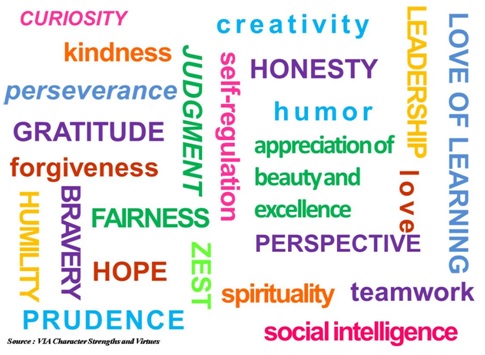 If we ask anyone, including ourselves, to list our key strengths, we will likely come up with listing our skills (good listener, great tennis player, caring for others, etc.) as most people need to be made aware and use their strengths consciously. Additionally, listing strengths seems way more challenging than listing our development areas or gaps. It is driven by the fact that our brain is wired to focus on the negative; however, just being aware of this negativity bias of our brain is a big step to overcoming it. Because of the deep-seated negative bias and consistent research that the bad is stronger than the good (Baumeister, 2001), teaching clients to look for strengths and reframe their struggles is a significant paradigm shift.
If we ask anyone, including ourselves, to list our key strengths, we will likely come up with listing our skills (good listener, great tennis player, caring for others, etc.) as most people need to be made aware and use their strengths consciously. Additionally, listing strengths seems way more challenging than listing our development areas or gaps. It is driven by the fact that our brain is wired to focus on the negative; however, just being aware of this negativity bias of our brain is a big step to overcoming it. Because of the deep-seated negative bias and consistent research that the bad is stronger than the good (Baumeister, 2001), teaching clients to look for strengths and reframe their struggles is a significant paradigm shift.
There are multiple possibilities to assess strengths, i.e., VIA Survey, Gallup’s StrengthsFinder based on the work of Donald Clifton or Standout by Marcus Buckingham, and many others. While all of these focus on measuring positive qualities, the main reason for my choice to apply VIA’s character strength approach is that while the others are more focused on talents and skills in a workplace setting (being an objective measure of talent), VIA survey focuses on universal strengths of character. As Seligman (2002) described, character strengths are the backbone of the field of positive psychology and the central pathway to five core areas of well-being. VIA Survey is a non-profit organization whose researches are open to all scientists for peer review, applies to all domains, and offers a common language instead of specific talent themes, helping clients benefit from their coaching program beyond the development of their leadership or any skills. For a short comparison of StrengthsFinder and VIA survey and a list of strengths assessed, see Appendix 1.
The VIA 24 character strengths, as a group, are a common language that describes what is best in human beings. Understanding that this language is not a random assembly of positive words is essential—quite the contrary, as it resulted from a 3-year project and collaboration among 55 well-known scientists. The result is a classification of six virtues found universally in human beings across religions, cultures, nations, and belief systems. After applying various strengths criteria, 24 character strengths emerged, strongly representing pathways to each of the six virtues.
The six virtues are:
- The Virtue of Wisdom (strengths that help to gather and use knowledge)
- The Virtue of Courage (strengths that help to exercise your will and face adversity)
- The Virtue of Humanity (strengths that help in one-on-one relationships)
- The Virtue of Justice (strengths that help us in community or group situations)
- The Virtue of Temperance (strengths that help us manage habits)
- The Virtue of Transcendence (strengths that help to connect outside of yourself)
Character strengths have been studied across industries, professions, application areas, areas of well-being, valued outcomes, and domains of life. For an overview of research in character strength science, see VIA Institute.
One of the great things about character strengths is that although we all have 24, and it’s a common language that allows us to easily express our understanding and appreciation of each other’s qualities, we each represent our strengths uniquely. Interventions and strategies can evolve from this mutual understanding, and discussions can arise where clients and coaches jointly recognize strengths.
Leadership Coaching Strength-Based
A character strengths-based coaching approach is empowering, energizing, and connecting, in which Coaches, in their own uniquely personal way and with their orientation/approach to helping, embody and exhibit their character strengths as they educate clients on strengths and support clients in cultivating their character strengths for boosting well-being and handling adversity.
7 Key Elements of Character Strength-Based Practice
Embodies character strength: Coaches serve as role models for utilizing character strengths. To demonstrate awareness and use of their character strengths as they interact and practice.
Educates on strengths: Coaches teach about strengths, explain their rationale and importance, correct misconceptions, and offer ways to benefit from character strength use.
Energizes: According to Biswas-Diener (2011), it moves the person out of “autopilot” mode, their established mental and behavioral routines, and strengths blindness patterns.
Empowers: Focus on character strengths to help clients transition from what’s wrong to what’s strong and use what’s strong to overcome what’s wrong.
Faces adversity: Acknowledge problems and struggles – and explore them when appropriate to the context/relationship, not allowing clients to get lost in them or to overrule the positive.
Connects: The character strengths approach creates connections, and it helps a Client develop a deeper connection with others, the world, and themselves. Of course, this connection naturally extends to the Coach-Client relationship.
Cultivates seeds: provides orientation for growing seeds, not just picking weeds (negatives). Rather than a prescriptive approach, descriptive language about character strengths is prioritized to build, explore, and assist clients in moving toward positive behavior (Niemiec, 2014).

Applying the DARE model (Coaching model Anita Szabo, ICA) provides a framework supporting clients to benefit from using their strengths through 4 steps:
- Discover: Introducing the strengths approach, the client takes the VIA survey
- Assess: Exploring&connectingthe Client’s strengths, identify signature strengths
- Response: Creating action plans, making strengths part of the Client’s routine
- Elevate: Appreciating the progress, affirming new habits
Relevance of Strength-Based Approach in Leadership Coaching
There are several theories about that what makes someone a good leader. Many resources list the top 5/7/10/15, etc., essential qualities or personality traits a good leader should possess. Some list only specific skills, while others focus on particular personality traits. Communication skills, confidence, empathy, inspiration, and creativity are undoubtedly essential qualities of a good leader; however, we must consider every leader unique.
Using their unique strengths to reach their full potential is far more beneficial than working in isolation to develop some leadership qualities listed.
Potential Value in Leadership & Workplace Context
Clients become not just familiarized with their own strengths; they can apply the strength-based approach to recruit based on strengths, have better development discussions with their team members based on their own strengths, and map out their team’s strengths which helps them to assign tasks and projects better.
Peter Fisk summarized ten main reasons to focus on strengths regardless of the job description based on reports from studies:
- Being happier: lower level of depression, better vitality, and good mental health
- Experiencing less stress: a higher level of positivity, creating a buffer against the adverse effects of stress
- Feeling healthier & having more energy: leading an active life, pursuing enjoyable activities, and eating well
- Feeling more satisfied with one’s life: leading to being a better problem solver, showing better performance at work, being more resistant to stress
- Being more confident: strength knowledge and use are strongly interconnected with self-esteem, self-efficacy, self-acceptance, and self-confidence.
- Experiencing faster growth & development: positive self-monitoring and strength-building are helping when learning something new or difficult.
- Being more creative and agile at work: helping people to better adapt to change, being engaged in more creative and proactive behaviors.
- Experiencing more meaning in their work: people who use more than four of their top strengths are more likely to experience job satisfaction, pleasure, engagement, and meaning in their work.
- Being more engaged in work: people who have the opportunity to use their strengths at work each day regularly are up to six times more engaged in what they are doing.
- Managers who focus on people’s strengths experience improved team success and performance.
Focusing on character strengths within organizations can also be vital as talents can be lost, resources can be quickly wasted, interests fade in change, and skills disappear over time. However, when all seems completely lost, the people still have their character strengths. Focusing on these allows the character strengths to crystallize, develop, and contribute to the greater good. Using character strengths at work improves employee engagement, job satisfaction, and well-being. An extensive amount of research is available on the VIA Institute site about using Character strengths in the workplace and organizations.
Ryan Niemiec provides several interventions for practitioners to work with character strengths, see some examples in Appendix 3.
Potential Watch Out and Misconceptions about Using Character Strengths
Character strength interventions should not be applied blindly; they must be individualized and placed in the context of the client.
Undoubtedly, focusing on strengths vs. weaknesses is more energizing and beneficial for the client! However, over-focusing on strengths might be a drawback, e.g., overuse of strengths or ignoring lesser ones. The right balance is developing some essential lesser strengths with the support of the Client’s top/signature strengths.
In a strengths-based leadership coaching context, the most common misconception is that to be a leader, one must have the strength of Leadership as a top strength.
In fact, not all leaders, even all good leaders, have Leadership as one of their top strengths. Across all demographics, leadership is a strength that falls right in the middle of the average profile. Like with any strength, there are people with Leadership as one of their top strengths; however, this doesn’t make them automatically a good leaders.
We know that successful leaders recognize, appreciate, and nurture the strengths of the people they lead. They play to their strengths and acknowledge that as leaders, they don’t have to know all the answers or even provide all the structure and guidance. Their job is to create an environment where their teams can grow and perform at their best. And, of course, they know their strengths and leverage them to get the best of themselves.
Most Important Concepts Related to Character Strength to Explore
Signature Strengths:
Signature strengths are central to who the person is and best capture their uniqueness or essence. They are also likely more energizing to use and more natural to express than the other strengths in the person’s profile.
We can help the client to identify those applying the „3E” model defined by Niemiec and McGrath (2019):
- character strengths that are essential or best reflect who the person is at their core;
- energizing in that expressing strength is uplifting and elicits an increase in energy levels;
- and effortless in that the expression is easy and natural
There are many hallmarks of success in leveraging our signature strengths. It’s straightforward to do: Coaches don’t have to change their style or approach, Clients find immediate benefits, it has scientific support, and it’s novel and unique for clients who are used to focusing on what’s wrong within themselves.
That is why it is crucial to motivate the client to prioritize their signature strengths – while all 24 character strengths matter – as mastering those will most likely give the highest benefit and support in reaching their goals. To master those, the most straightforward exercise is to ask the Client to come up with ideas on how they can use their signature strengths in new ways.
Happiness Strengths:
Numerous studies across cultures consistently identify a handful of character strengths that correlate most strongly with life satisfaction. Those strengths, starting from (typically) the strongest correlation, are zest, hope, love, gratitude, and curiosity.
Lower Strengths:
These character strengths emerge in the bottom 4–7 of the Client’s profile. These are not viewed as weaknesses but rather as either undeveloped, unrealized, not as valued as other strengths, or, at the least, less used compared to other strengths in the profile.
Middle Strengths:
Character strengths that are most likely to support or enhance the display of the Client’s signature strengths. Often called “supportive strengths,” these reveal the middle of the character-strengths profile.
Lost Strengths:
These character strengths have been inactive or eroded from the Client’s consciousness and use. These may have been suppressed by authority figures or discouraged due to cultural or social pressures. A lost strength can be any strength in the Client’s profile.
Over- And Underusing Strengths
Strength overuse happens when someone puts forth their strength(s) too firmly in a particular situation. There is often no awareness around it, meaning being “blind” about the impact.
We all underuse our strengths time-to-time. Sometimes individuals minimize or downplay their strengths or, at best, are matter-of-fact about having their strengths.
Researchers recently found that underusing or overusing our strengths can increase social anxiety and negatively impact well-being. For example, if we overuse the power of humility, we risk cutting ourselves off from others to avoid judgment. And if we underuse our sense of humor, we might be seen as too serious; if we underuse our zest for life, we’ll be less eager to socialize. See a list of optimal/over and underuse for each character’s strengths in Appendix 2.
Hot Buttons:
Everybody has character strengths, “hot buttons,” or sensitive areas in which other person’s strengths use is seen as strengths overused or underused and trigger discomfort/frustration. Usually, this stems from beliefs, preferences, or expectations from our own character strengths.
Hot buttons can be the source of conflicts, strengths collisions, and/or even explain why a problem is happening.
Strength-Based Leadership Coaching
As several researches support, character strengths play a substantial role in boosting well-being and handling adversity. When appropriately applied in a coaching context to support the Client’s growth and agenda as a tool rather than the primary purpose of the coaching sessions, the character-strength-based approach can assist the Client in unleashing their leadership potential and being their authentic self, delivering benefits far beyond their role.
Appendix 1
Via Classification of Virtues and Character-Strengths
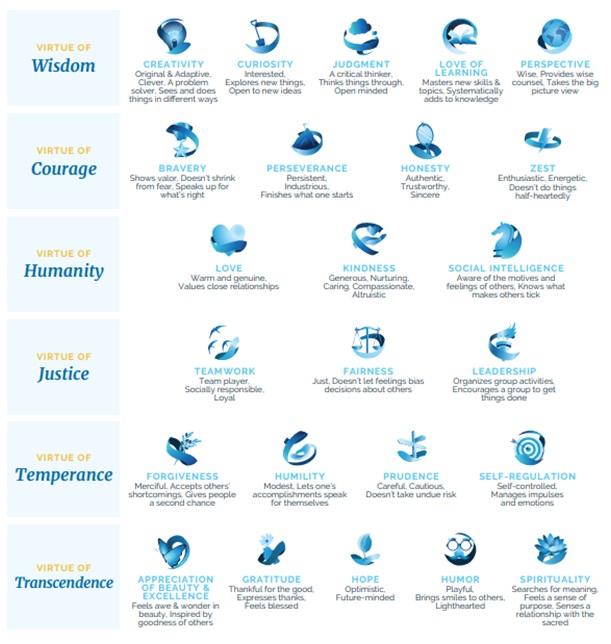
Gallup Strengthsfinder’s Summary of 4 Domains & 34 Strengths
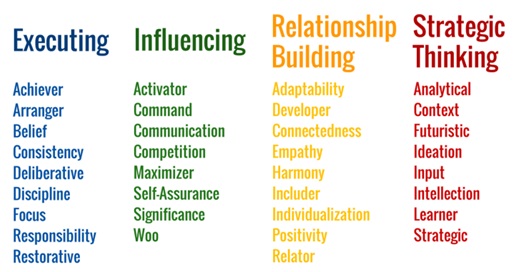
Strengthfinder & via Survey High-Level Comparison Chart
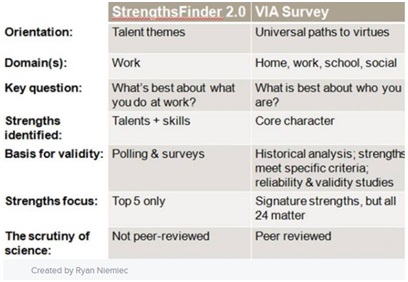
Appendix 2
Under/Over/Optimal Use of Character-Strengths
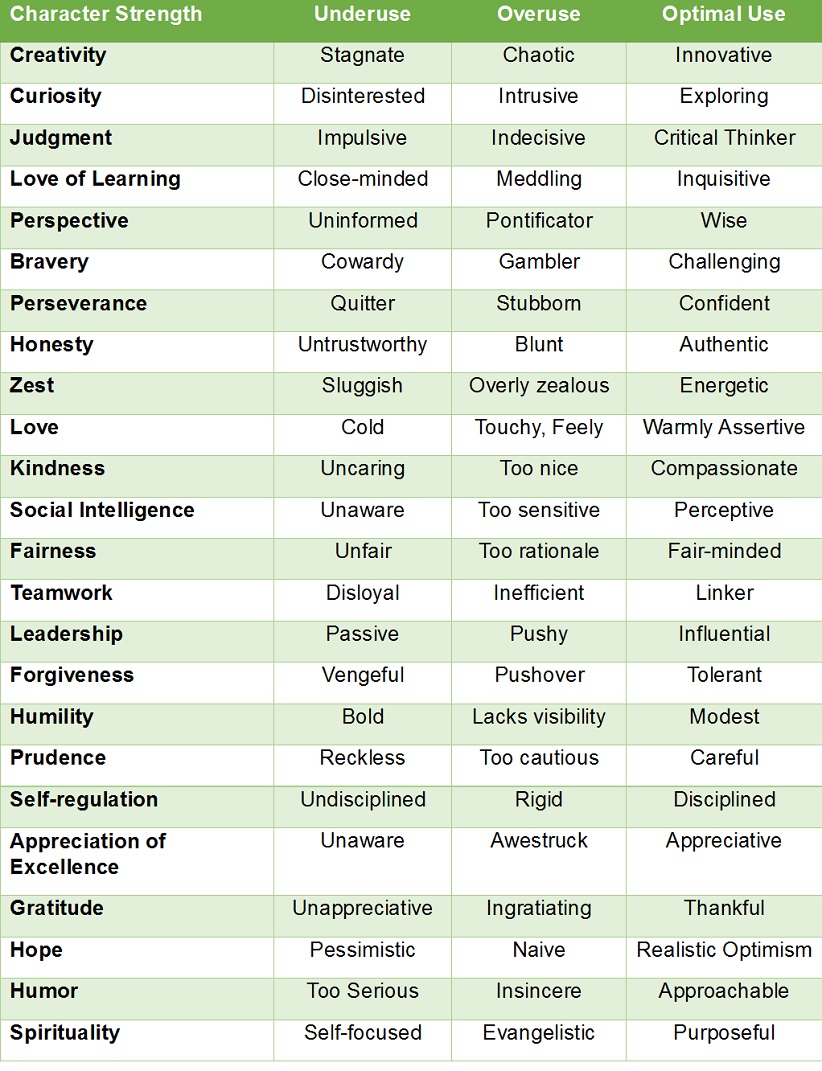
Appendix 3
Character-Strength Interventions
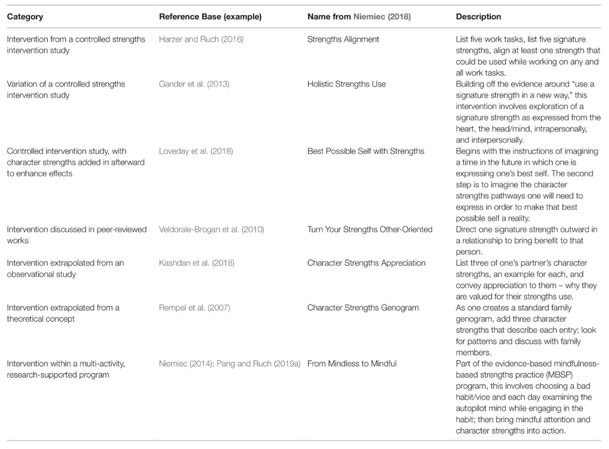
References
VIA Institute on Character: https://www.viacharacter.org/
Ryan M. Niemiec (2018, Hogrefe Publishing): Character Strengths Interventions
Ryan Niemiec, Ruth Pearce (Jan 2021): The Practice of Character Strengths
Ruth Pearce: Good Leaders Know How to Use Their Unique Strengths (Apr 2019)
Peter Fisk(Jan 15, 202a): What are your strengths as a leader? Positive psychology proposes six virtues and 24 character strengths: https://www.peterfisk.com, michellemcquaid.com
Jeremy Sutton, Ph.D. (Jul 2020): 10 ways to build character strengths at work
Charles D. Kerns, Ph.D., MBA: Leading from Character Strength (Graziano Business Review 2013 Volume 16): https://gbr.pepperdine.edu
Anita Szabo: Coaching model DARE, ICA: https://forum.icacoach.com/discussion/150657/dare-coaching-model#latest

/iPEC%20Coaching/iStock-1372029359.jpg#keepProtocol)
/iStock-1395144844_blog.jpg#keepProtocol)

